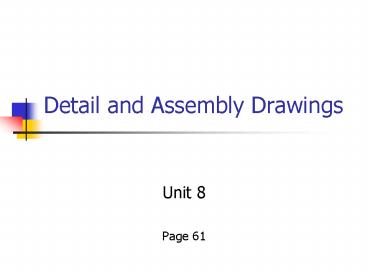Detail and Assembly Drawings - PowerPoint PPT Presentation
1 / 18
Title:
Detail and Assembly Drawings
Description:
Identify detail drawings and information on them. ... 2. Assembly drawings for units to. be ... Found in Chilton manuals. Exploded Pictorial Assembly. Summary ... – PowerPoint PPT presentation
Number of Views:3782
Avg rating:3.0/5.0
Title: Detail and Assembly Drawings
1
Detail and Assembly Drawings
- Unit 8
- Page 61
2
Objectives
- Identify detail drawings and information on them.
- Identify assembly drawings and information on
them. - Identify various types of assembly drawings.
3
Introduction
- Two basic types of drawings.
- 1. Detail drawings for parts
- produced.
- 2. Assembly drawings for units to
- be put together.
4
Detail Drawings
- Drawings made for a single part.
- One part on one print.
- Provides all of the information necessary to
produce the individual part.
5
Detail Drawings
- Detail drawings provide the following
information. - 1. Name of the part.
- 2. Shape description of the part.
- 3. Sizes of the features.
- 4. Notes on materials, heat treat, and
- finishing processes.
6
Detail Drawing
7
Assembly Drawings
- Drawings that show the working relationship of
parts and how they go together. - Made up of two or more parts.
8
Assembly Drawings
- Assembly drawings provide the following
information. - 1. Name of assembly.
- 2. Relationship of one part to another.
- 3. List of parts.
- 4. Bill of materials.
- 5. Overall sizes when necessary.
9
Sub-assembly Drawings
- Drawings that include only part of the overall
assembly. - Saves time and can show better description of
parts. - Example Drill press
10
Working Assembly
- Fully dimensioned drawings that combine detail
and assembly parts. - Only used on simple parts with a small number of
details.
11
Working Assembly
12
Diagram Assembly
- Drawings that make use of conventional symbols.
- Used in piping and wiring diagrams.
- Used on schematics.
- Used in floor plans.
13
Diagram Assembly
14
Installation Assembly
- Provide necessary information to install a piece
of equipment. - Half of the part is made in a shop, and the other
half is put together in the field - Examples Dust collector
- Walls for workshop in video.
15
Exploded Pictorial Assembly
- Shows the parts in an exploded view.
- Used mostly in the automotive field.
- Found in Chilton manuals.
16
Exploded Pictorial Assembly
17
Summary
- What are the two main types of drawings found in
industry? - What information does a detail drawing give us?
- What information does an assembly drawing give
us? - What are the 5 different types of assembly
drawings we discussed?
18
Assignment
- Do print reading activity 8-PR-1 on page 65.
Answer questions 1-16.































